Smart Home - Universal Automation

The term "Smart Home" today is called a room in which there are several connected electronic devices and electrical appliances, specially programmed to perform certain actions. Their task is to save money, electricity and user efforts.
Such a system is sometimes called “home automation”, and its simple manifestations are present in many modern homes. An example of such a “primitive” system is automatic garage doors.
')
Today’s smart systems are much more advanced. They can include several devices at once, which can be controlled via the Internet. It all started with the idea of the so-called Internet of Things (Internet of Things) - a wide network of smart devices that are able to collect and analyze data and make their own decisions based on them.
One of the first to emerge was the security and alarm systems, which, using sensors, determine, for example, whether a door was open. If, when a sensor is triggered, a secret password is not entered, the system may give an alarm and notify the special services.
Today's home security systems fit in the palm of your hand, and you can control them from anywhere and at any time with your smartphone. Examples of such systems are Cocoon, Piper, Kibbi, which have a microphone, a speaker, a siren, and an automatic protection on / off system based on the GPS sensor of a mobile device. Sometimes these devices are able to "learn" about the activity in nearby areas.
An integral part of home security systems are smart video surveillance systems. A small video camera is a small server that has its own Internet address. With the advent of the smart home, it became possible to carry out video surveillance from any distance, and not just in close proximity, as before. Production of such devices are engaged in many suppliers, among which are Smarthome, Insteon, Q-See.
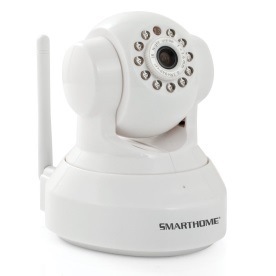
Insteon and Smarthome cameras
According to Statista.com, in 2015 the Russian security market is estimated at $ 8.8 million, and by 2020 this amount will increase to $ 59 million. If we touch on the issue of the number of dwellings with smart security systems, then today this figure is 28 thousand houses, and by 2020, according to forecasts, will increase to 240 thousand.


The revenue of the security systems market in Russia and the number of houses equipped with such systems
The functionality of such systems can be expanded by fire alarm systems that inform you about smoke, fire, and excess carbon dioxide or other gas, such as methane.
However, smart homes are able to provide not only security, but also human comfort. Audio / video components installed throughout your home can be controlled from a single device, such as a smartphone or tablet computer.
This is the so-called “Multiroom” system. The user can listen to music in any room and even “carry” it from room to room. Even such smart systems allow you to program the inclusion of the music center or TV at a certain time, say, when you come home from work.
According to Statista.com, in 2015 the market for smart home entertainment systems in Russia is estimated at $ 10.3 million. By 2020, this amount could grow to $ 70 million. The number of houses should increase from 31 thousand to 350 thousand.

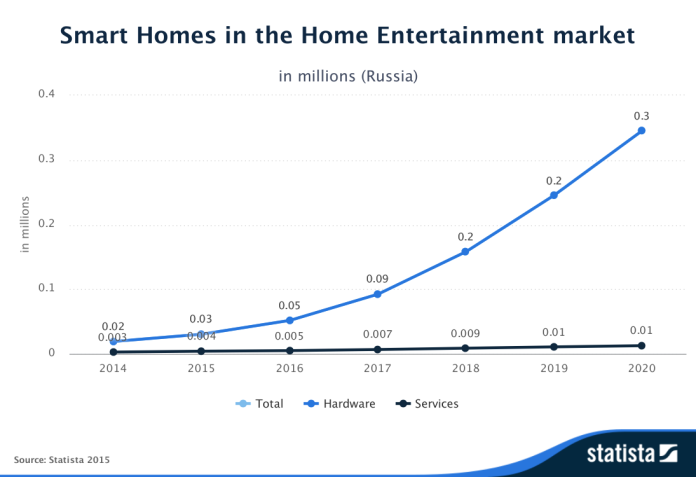
Market revenue for smart home entertainment systems in Russia and the number of houses equipped with such systems
Such decisions can control the lighting in different parts of the house or apartment, adapting to the mood of the owner. In general, lighting control is one of the first areas in which the smart home began to develop.
Today, a large number of such systems and devices are available - these are smart switches, light bulbs , touch-sensitive or push-button panels, light and presence sensors.
For example, Nanoleaf offers smart diode lamps, which can be controlled both manually and by voice commands using a smartphone, and Belkin supplies smart switches. With the help of " smart light ", the user can adjust the illumination at will, for example, at nightfall, turn on the light in the courtyard of the house and turn it off with the dawn.
If a person wants the light to turn on when entering the bathroom and turn off when leaving it, then a motion sensor connected to a switch that sends the appropriate signals will help. The combinations of sensors and smart devices are just a sea.

Nanoleaf lamps
According to Statista.com, in 2015 the Russian market for lighting automation systems, as well as other sensors and sensors, is estimated at $ 20 million in Russia, and by 2020 this amount should increase to 108 million (the number of houses equipped with these systems by 2020, it is projected to be 400 thousand).
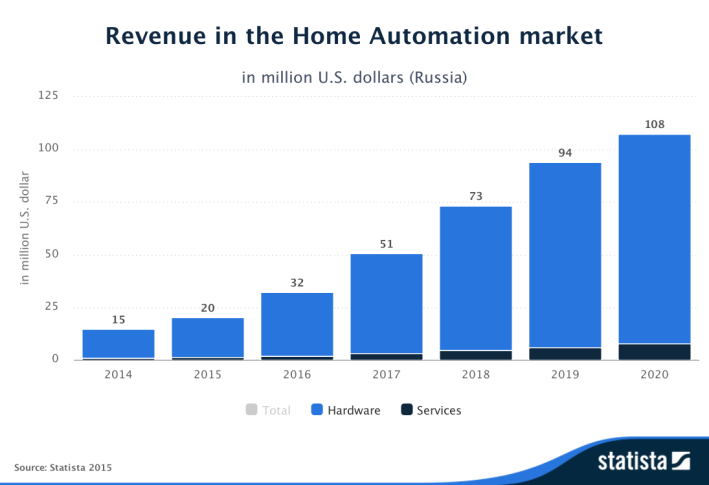
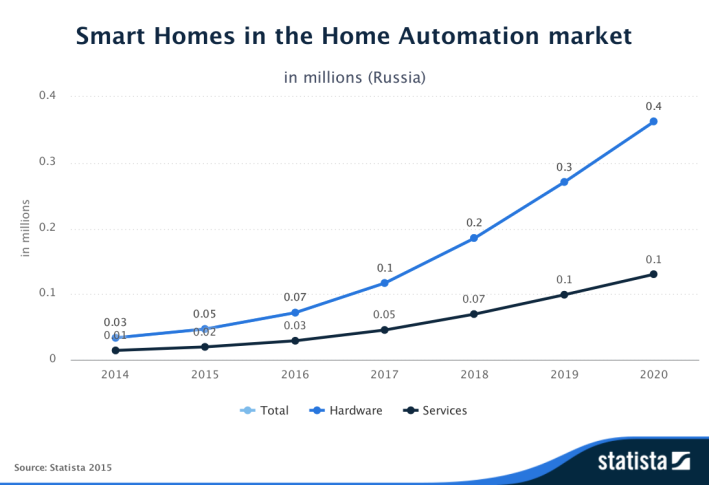
Market revenue for lighting automation systems in Russia and the number of houses equipped with such systems
Important elements of comfort are air conditioning, heating and ventilation. The cost of heating and cooling apartments every year are becoming more and more noticeable, and there is no doubt that devices that can help save on this will soon occupy their niche in the market.
Several advanced programmable thermostats are already on sale, allowing you to control several heating and air-conditioning systems at once. For example, Nest is the brainchild of a company bought by Google, the number of sales of which has already exceeded one million, as well as ecobee3, tado, Honeywell.

Pictured: ecobee3
Such devices can significantly save money on electricity. Many of them are configured and controlled remotely, using a smartphone, and also keep statistics on energy consumption, after studying which, you can find out how you can save more. Moreover, such systems can differently heat different areas of the house, depending on where you spend most of the time.
According to Statista.com, in 2015 the Russian market of smart air conditioning and heating systems is estimated at $ 9.9 million; by 2020, according to forecasts, this amount will increase to 58 million dollars. The number of homes with smart air conditioning systems today is 55 thousand; by 2020 their number should increase to 330 thousand.

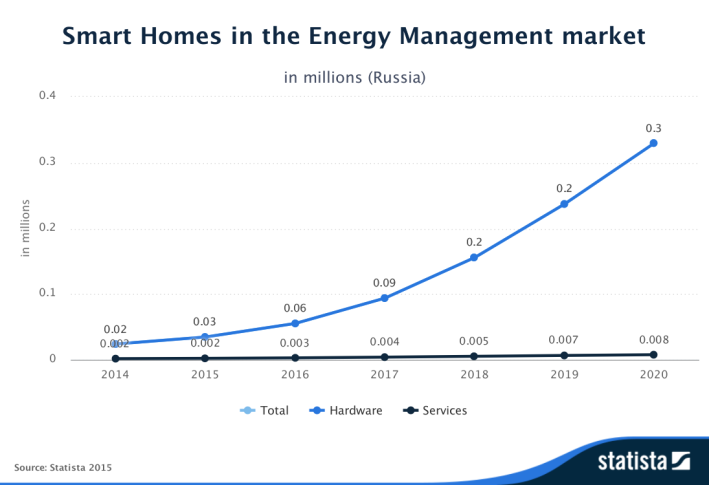
The revenue of the air conditioning and heating market in Russia and the number of houses equipped with such systems
The most interesting thing is that these revolutionary devices and systems come with their own applications and control hubs. If you buy several such systems, then it is better to immediately buy some closet where you place all the flashing, blinking and picking control mini-centers.
This is not to mention the fact that on your smartphone will be a huge number of applications that will need to constantly open, close and configure. Unless in the course of general automation our life should not have become a little easier?
Of course, complex solutions offered by large companies can be found on the market, but such systems are quite expensive. Moreover, their installation often requires the intervention of professionals. To solve this unpleasant problem, devices appeared on the market that allow them to introduce a smart system at home.
One example is the Lowe Iris automation system, on the basis of which a simple and scalable solution can be built. It makes it possible to combine an unlimited number of devices in a single interface (more than 50 items are supported) in order to manage them using one application. The system supports ZigBee and Z-Wave data transfer standards. As additional examples, SmartThings and Insteon solutions are systems based on a central hub to which sets of devices for various purposes can be connected.

"Inner World" hub SmartThings

Hub insteon
With the help of accompanying software, the user can perform the initial configuration of devices. After that, the hub turns into a tool that allows you to control and control home automation from anywhere in the world - it integrates the work of door locks, temperature sensors, window opening and closing sensors, smart sockets, lighting systems, fire alarm sensors and movement (in particular, Insteon can manage even the "lava lamp").
In addition, it acts as a warning system: for example, if a leakage sensor works in the house, the hub will immediately notify by email or through a proprietary application. In general, the key task of the hub is to turn your smartphone into a universal home control panel.
These systems and additional components for them began to be successfully sold in retail chains (such large networks as Ulmart and Amazon are already selling). Such an approach to building a smart home “in parts” allows you to build a decent automation system gradually, without spending a large amount of funds at once. It is as if you are buying Lego sets as needed, creating your dream home.
Source: https://habr.com/ru/post/369387/
All Articles